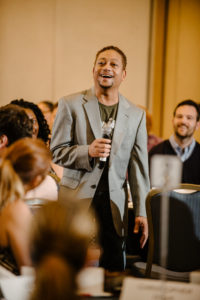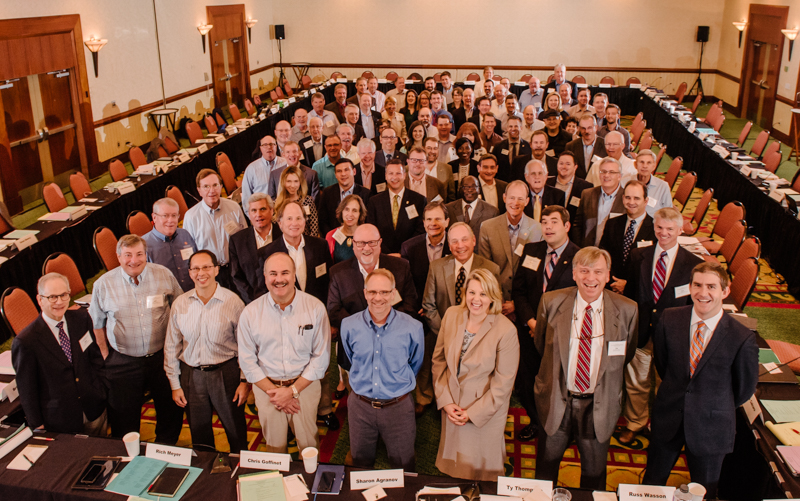Conference Event Photography Guide
Conference event photography is essential for documenting and enhancing the experience of corporate and professional events. We’ll provide practical insights for both photographers and event organizers on how to effectively capture the moments that define a conference.
Whether you’re a professional photographer or an event organizer, understanding these elements will help you use photography to its fullest potential, ensuring your event is not only memorable but also visually captivating.
The Importance of Conference Photography
Photographs from conferences can serve multiple strategic functions:
- Marketing: Use photos for marketing materials to showcase the atmosphere and success of your events, drawing more attendees and sponsors to future conferences.
- Branding: Strengthen your brand’s visual identity with professional images that reflect the quality and energy of your events on your website, in social media posts, and promotional materials.
- Conference Perk: Offering professional photos can be a valuable perk for speakers, and attendees will appreciate the memories captured as they reflect on their experiences.
Planning for The Conference Photoshoot
Efficient planning is crucial for successful conference photography:
- Photo Consent: Ensure all attendees are aware of and have consented to photography, typically handled by the event organizers.
- Set Expectations: Communicate with the organizers to understand the focus of the photography—whether it’s the speakers, the audience, or specific moments.
- Scout the Venue: Visiting the venue beforehand can help you identify the best spots for taking impactful photos, both of the event setup and during the conference itself.
- Gear Up: Be prepared with all necessary equipment, including extra batteries, memory cards, and charging cables, to handle the demands of a potentially long and busy event.
8 Tips for Conference Photographers
Blend in
In conference photography, being invisible helps you capture the most authentic moments. To blend in, move through the venue subtly without interrupting the speakers or the audience’s engagement. Position yourself in less conspicuous spots where you can still capture great shots without being in the direct line of sight of attendees.
You should also use natural lighting as much as possible and avoid the disruptive flash. Only decide to take posed photos in between talks or during breaks.
Introduce Yourself
Successful conference photography often starts with building connections with the key participants. Introducing yourself to speakers and event organizers before the event can help build rapport, making it easier to approach them for photos during the conference.
Wearing a clearly visible photographer badge helps attendees recognize your role, making them more comfortable being photographed and can facilitate smoother interactions throughout the event.
Lighting Matters
Effective management of lighting is crucial in conference photography. Each room can have different lighting conditions, and it’s important to adjust your camera settings accordingly.
Bringing small, portable reflectors can help soften harsh indoor lighting or enhance the natural light for better portraits. Familiarity with manual camera settings such as exposure, ISO, and shutter speed is key to adapting to varied lighting conditions quickly.
Quantity Leads to Quality
To ensure you capture the perfect moments, take advantage of your camera’s continuous shooting mode. This allows you to take multiple shots in quick succession, which is particularly useful during dynamic or spontaneous events. Additionally, shooting from various angles and perspectives will provide a comprehensive set of images, capturing the essence of the conference from every viewpoint.
Remember, you can always pick out the best shots after the fact.
 Candid Camera Moments
Candid Camera Moments
Candid photography is powerful for capturing the true essence and emotion of the conference. Aim to photograph attendees’ reactions during key speeches or presentations to capture their genuine emotions. Keep an eye out for unscripted moments, such as spontaneous interactions or reactions from the crowd, which often result in the most memorable and impactful images.
Take Some Videos, Too
While still photography is essential, incorporating video can capture aspects of the event that still images cannot. Shooting short video clips during key moments of the conference can provide dynamic content for social media and promotional materials. Consider creating a highlights reel post-event to summarize the conference’s key moments, providing a valuable recap for attendees and a promotional tool for future events.
Don’t Rely on Auto Mode
To truly capture the atmosphere of a conference, moving beyond auto mode and using manual camera settings is crucial. Manual focus can be particularly useful in challenging lighting conditions or when capturing fast-moving speakers. Understanding how to manually adjust your camera’s focus, exposure, and other settings allows for greater control and can lead to higher quality photographs.
Edit Like a Pro
Post-processing plays a significant role in conference photography, turning good photos into great ones. Gaining proficiency in photo editing software such as Lightroom or Photoshop enables you to enhance colors, adjust lighting, and crop images to highlight the key subjects or moments. Focusing on editing the most impactful photos can efficiently improve the overall quality of your photographic output, ensuring that the images are not only visually appealing but also aligned with the event’s branding and promotional goals.
If you aren’t experienced with editing, you may want to hire someone else to do so, but you can also look out for our upcoming blog post on this soon!
Final Thoughts on Mastering Conference Photography
Whether you’re a photographer looking to make your conference job perfect or an organizer trying to find the best conference photographer for your event, we hope these tips have helped you better understand conference event photography.
Remember, each photo tells a story, and mastering conference photography lets you tell it in the most compelling way possible.


 Candid Camera Moments
Candid Camera Moments